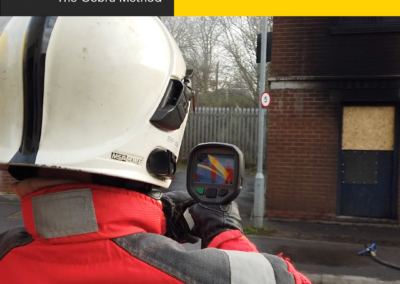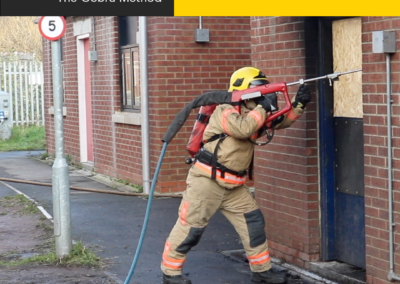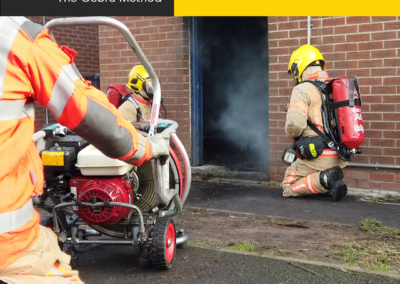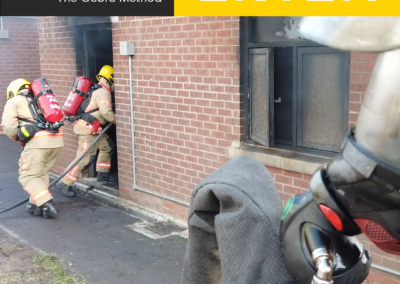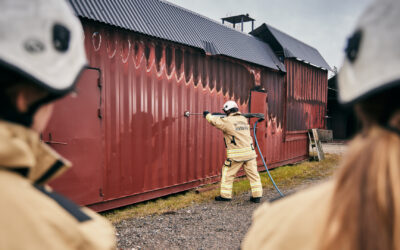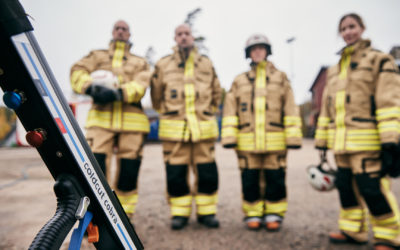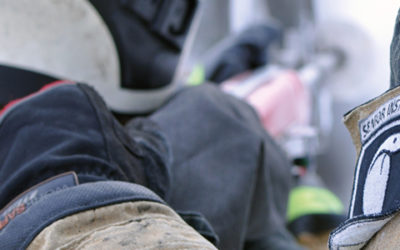The Cobra Method minimises the firefighter’s exposure to high temperatures, toxic smoke from fire-gases and other risks, decreasing short and long term occupational health effects. The Cobra Method may create a window of opportunity which enables the incident commander and crew to carry out tasks, such as rescue operations, which they would not been able to have done otherwise. The Cobra Method, SAVE, dynamically combines situation Scanning, ultra-high pressure water mist Attack from a safe external position, and tactical Ventilation before, or in conjunction with, Entering the fire compartment.
The Cobra SAVE method of Scan, Attack, Ventilate, and Enter is developed by firefighters. It is a dynamically applied method where each step could be used in any order.
S = Scan.
Scan means that you should gather information from all available sources and use all your senses and experience. Scan with a thermal imaging camera, use your bare eyes, drones, collect information from the property owner, look at floor plans, and get local knowledge from crews. The Scan step includes not only gathering information but also creating new information based on the scanned information – for instance, risk assessment. The risk assessment then indicates what to do next. Always continuously scan the situation in order to change tactics as the situation changes.
A = Attack.
The Incident Commander orders a Cobra attack. The information gained from the scan will indicate what tactic to use and where to attack with Cobra. The decision could be to use Cobra to minimise risk, save lives, stop spreading of fire or some other purpose. Significant amounts of steam can be seen, showing the cooling effect of the Cobra deployment. Continue to scan to monitor the effect and efficiency of the applied tactics. To give feedback to the Cobra operator is vital as he/she can only see the wall in front. The information gained from the scan will indicate what to do next.
V = Ventilate.
When information from the scan indicates that the temperature is down in the fire compartment, it might be time to start ventilating. The objective of ventilating is to get rid of smoke/steam to increase visibility. In order to ventilate, you need at least two openings, one inlet and one exhaust or outlet. When choosing ventilation direction, consider wind direction. It is hard to ventilate against the wind. Practice with PPV in order to understand how wind and building layouts affect ventilation. Most risks may be mitigated by appropriate measures.
E = Enter.
Analyse the outcome of previous steps and measures taken. If the fire compartment is cooled down and the ventilation is adequate, it is time to enter. The remaining fire can now be extinguished. Visibility should be greatly improved with the assistance of PPV. Work quickly but cautiously, according to your BA regulations, and be aware that small fires may remain after the Cobra attack, and they will increase if given enough time. Internal firefighting exposes Firefighters to significant risks, both physical and psychological. The Cobra Method of Scan, Attack, Ventilate and Enter – SAVE – offers a far safer firefighting option.
